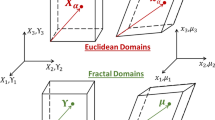Abstract
It has been long observed that cumbersome parameters are required for the traditional viscoelastic models to describe complex rheological behaviors. Inspired by the relationship between normal and anomalous diffusions, this paper tentatively employs t α to replace t, called as the scaling transformation, in the traditional creep compliance and relaxation modulus. With this methodology, the relaxation modulus is found to agree with the well-known Kohlrausch-Williams-Watts (KWW) stretched exponential function. The fitting results confirm that the proposed models accurately characterize rheological behaviors only with one more parameter α. Moreover, it is noted that the present formulations are directly related to the fractal derivative viscoelastic models and the index α is actually the order of the fractal derivative.






Similar content being viewed by others
References
Bagley RL, Torvik PJ (1986) On the fractional calculus model of viscoelastic behavior. J Rheol (1978-present) 30:133–155
Betten J (2008) Creep mechanics. Springer Science & Business Media, Berlin
Blair GS, Caffyn J (1949) VI. An application of the theory of quasi-properties to the treatment of anomalous strain-stress relations. London, Edinburgh Dublin Philos Mag J Sci 40:80–94
Bouchaud J-P, Georges A (1990) Anomalous diffusion in disordered media: statistical mechanisms, models and physical applications. Phys Rep 195:127–293
Cai W, Chen W, Xu W (2016) Characterizing the creep of viscoelastic materials by fractal derivative models. Int J Non-Linear Mech 87:58–63. https://doi.org/10.1016/j.ijnonlinmec.2016.10.001
Chen W (2006) Time–space fabric underlying anomalous diffusion. Chaos, Solitons Fractals 28:923–929
Chen W, Sun H, Zhang X, Korošak D (2010) Anomalous diffusion modeling by fractal and fractional derivatives. Comput Math Appl 59:1754–1758
Cristescu N (1993) A general constitutive equation for transient and stationary creep of rock salt. Int J Rock Mech Min Sci Geomech Abstracts, vol 30. Elsevier, pp 125–140
Cushman JH, O’Malley D, Park M (2009) Anomalous diffusion as modeled by a nonstationary extension of Brownian motion. Phys Rev E 79:032101
Di Paola M, Zingales M (2012) Exact mechanical models of fractional hereditary materials. J Rheol (1978-present) 56:983–1004
Dieterich W, Maass P (2002) Non-Debye relaxations in disordered ionic solids. Chem Phys 284:439–467
El Abd AE-G, Milczarek JJ (2004) Neutron radiography study of water absorption in porous building materials: anomalous diffusion analysis. J Phys D Appl Phys 37:2305
Fang XJ, Xu YC, Shi TY, Zhang L, Li ZF (2007) Stress and continuous relaxation spectrum of porcine cornea after LASIK. Int J Ophthalmol 1:113–116
Ferguson H, Gardner WH (1963) Diffusion theory applied to water flow data obtained using gamma ray absorption. Soil Sci Soc Am J 27:243–246
Freund JB, Ewoldt RH (2015) Quantitative rheological model selection: good fits versus credible models using Bayesian inference. J Rheol 59:667–701. https://doi.org/10.1122/1.4915299
Jaishankar A, McKinley GH (2012) Power-law rheology in the bulk and at the interface: quasi-properties and fractional constitutive equations. Proc R Soc A. The Royal Society, pp rspa20120284
Küntz M, Lavallée P (2001) Experimental evidence and theoretical analysis of anomalous diffusion during water infiltration in porous building materials. J Phys D Appl Phys 34:2547
Kim HJ (2014) Anomalous diffusion induced by enhancement of memory. Phys Rev E 90:012103
Li C, Shi Q, Li B (2001) Experimental investigations and derivation of model for the relaxation of saturated soft clays. Soil Eng Foundation 15:38–40
Mainardi F (2010) Fractional calculus and waves in linear viscoelasticity: an introduction to mathematical models. World Scientific
Metzler R, Klafter J (2000) The random walk’s guide to anomalous diffusion: a fractional dynamics approach. Phys Rep 339:1–77
Milovanov AV, Rypdal K, Rasmussen JJ (2007) Stretched exponential relaxation and ac universality in disordered dielectrics. Phys Rev B 76:104201
Nutting P (1921) A new general law of deformation. J Franklin Inst 191:679–685
Schiessel H, Metzler R, Blumen A, Nonnenmacher TF (1995) Generalized viscoelastic models: their fractional equations with solutions. J Phys A Math Gen 28:6567
Sollich P, Lequeux F, Hébraud P, Cates ME (1997) Rheology of soft glassy materials. Phys Rev Lett 78:2020
Sun H, Chen W, Li C, Chen Y (2010) Fractional differential models for anomalous diffusion. Phys A: Stat Mech Appl 389:2719–2724
Sun H, Meerschaert MM, Zhang Y, Zhu J, Chen W (2013) A fractal Richards’ equation to capture the non-Boltzmann scaling of water transport in unsaturated media. Adv Water Resour 52:292–295
Szabo TL, Wu J (2000) A model for longitudinal and shear wave propagation in viscoelastic media. J Acoust Soc Am 107:2437–2446
Tschoegl NW (2012) The phenomenological theory of linear viscoelastic behavior: an introduction. Springer Science & Business Media
Vlad MO, Metzler R, Nonnenmacher TF, Mackey MC (1996) Universality classes for asymptotic behavior of relaxation processes in systems with dynamical disorder: dynamical generalizations of stretched exponential. J Math Phys 37:2279–2306
Wang Z, Yin K, Jian W, Zhang F (2008) Experimental research on stress relaxation of slip zone soils for Anlesi landslide in Wanzhou city. Chin J Rock Mech Eng 27:931–937
Wharmby AW, Bagley RL (2013) Generalization of a theoretical basis for the application of fractional calculus to viscoelasticity. J Rheol (1978-present) 57:1429–1440
Williams G, Watts DC (1970) Non-symmetrical dielectric relaxation behaviour arising from a simple empirical decay function. Trans Faraday Soc 66:80–85
Yin Q, Wang SM (2006) The flabby model of saturated soil establishment and verification. J Heilongjiang Hydraul Eng Coll 33:24–26
Funding
The work described in this paper was supported by the National Natural Science Foundation of China (No. 11702084, 11402076), the Fundamental Research Funds for the Central Universities (2017B03114), the 111 project (Grant No. B12032), and Natural Science Foundation for Jiangsu Province (Grant No. BK20130841).
Author information
Authors and Affiliations
Corresponding author
Rights and permissions
About this article
Cite this article
Cai, W., Chen, W. Application of scaling transformation to characterizing complex rheological behaviors and fractal derivative modeling. Rheol Acta 57, 43–50 (2018). https://doi.org/10.1007/s00397-017-1054-8
Received:
Revised:
Accepted:
Published:
Issue Date:
DOI: https://doi.org/10.1007/s00397-017-1054-8



